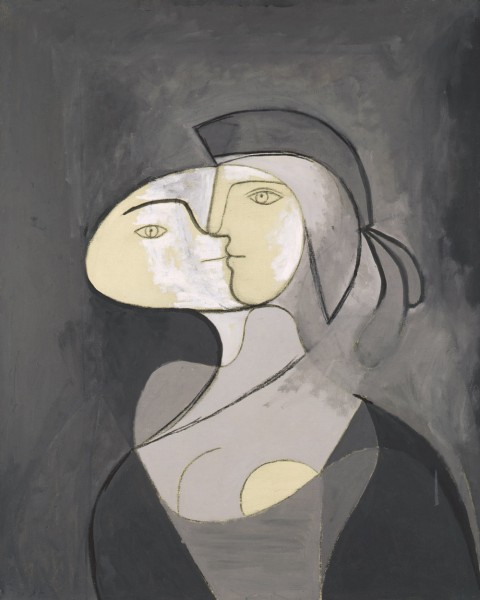
Pablo Picasso, “The Milliner’s Workshop (Atelier de la modiste),” oil on canvas, January 1926 (© 2012 Estate of Pablo Picasso/Artists Rights Society, New York. Photo: © CNAC/MNAM/Dist. Réunion des Musées Nationaux/Art Resource, NY)
Solomon R. Guggenheim Museum
1071 Fifth Ave. at 89th St.
Friday – Wednesday through January 23, $18 (pay-what-you-wish Saturday 5:45-7:45)
212-423-3587
www.guggenheim.org
“You capture more of the reality of a picture in black and white,” says Maya Widmaier-Picasso on the audioguide to the illuminating exhibition “Picasso Black and White,” which continues at the Guggenheim through January 23. The excellent audio tour, featuring contributions from Picasso’s daughter with muse and mistress Marie-Thérèse Walter as well as curator Carmen Giménez and longtime Picasso friend and art critic Carlos Casagemas, is a splendid accompaniment to the gorgeous visuals, more than one hundred sculptures, paintings, and drawings that focus on Picasso’s rich, passionate use of black, white, and gray. Arranged chronologically, the show also reveals how Picasso’s personal life, from his relationships with women to his strong antiwar, anti-Franco stance, informed his work. The monochromatic canvases allow viewers to rejoice in Picasso’s revolutionary use of line, form, and composition, from the stark simplicity of “The Lovers” and “Sleeping Woman” to such more dense and complex pieces as “The Milliner’s Workshop” and “The Charnel House.” While “Composition and Volume” and “Head Seen Three-Quarters from the Left (Figure)” are oil paintings of sculptures that attain a compelling three-dimensionality, “Head” and two versions of “Sylvette” are like three-dimensional paintings, the ponytail on the latter two said to have influenced Brigitte Bardot. The exhibition also examines how Picasso went through a long period of creating works based on those of other artists, reclaiming them for himself, from Eugène Delacroix (“The Rape of the Sabines”) to Diego Velázquez (“The Maids of Honor [Las Meninas]”).

Pablo Picasso, “Marie-Thérèse, Face and Profile (Marie-Thérèse, face et profil), oil and charcoal on canvas, 1931 (© 2012 Estate of Pablo Picasso/Artists Rights Society, New York. Photo: Béatrice Hatala)
Featuring still-lifes, portraits, and vibrant depictions of horrific actions (“Mother with Dead Child II, Postscript to Guernica”), the show explores the strong emotions that Picasso put into his work — and those that are taken away by the viewer. Along the way, Widmaier-Picasso shares charming stories about her father, calling him “a blockhead,” describing how he’d walk on tiptoe away from a painting he was working on in order to see it better, and recalling his fondness for making late-night fried eggs. “I paint objects as I think them, not as I see them,” Picasso once famously said. “Picasso Black and White” delves into the deep thought processes that went into this impressive body of work. “Picasso Black and White” comes to a close with an afternoon/evening symposium on January 23, “Monographic Motifs: One Artist, One Theme, 1900-1970,” with presentations from Richard Schiff (“De Kooning: The Kick, the Twist, the Woman, the Rowboat”), Genevieve Hendricks (“Le Corbusier’s Fantastic Femmes”), Anna Ferrari (“From Mosaics to ‘Magic’: Henri Laurens’s Red-Ochre Drawings,” with a response by Kenneth Silver), Fernando Herrero-Matoses (“Antonio Saura and the Crucifixion: Facing Picasso in Black-and-White”), Catherine Spencer (“Prunella Clough’s Cold War Cartographies,” response by Anne Umland), and Giménez, Diana Widmaier Picasso (Maya’s daughter), and Gary Tinterow (“Picasso: A Conversation”), followed by a reception and a final viewing of the exhibition.